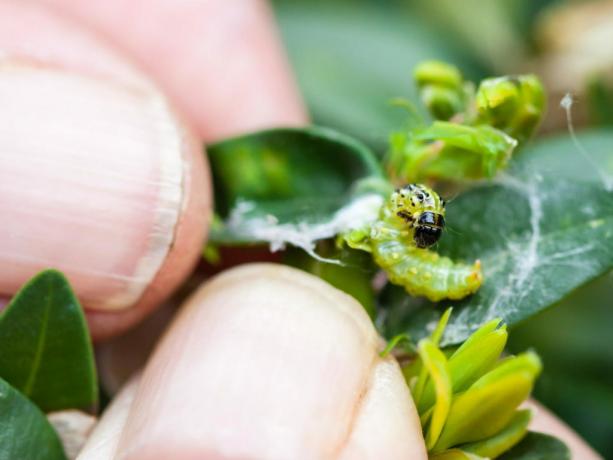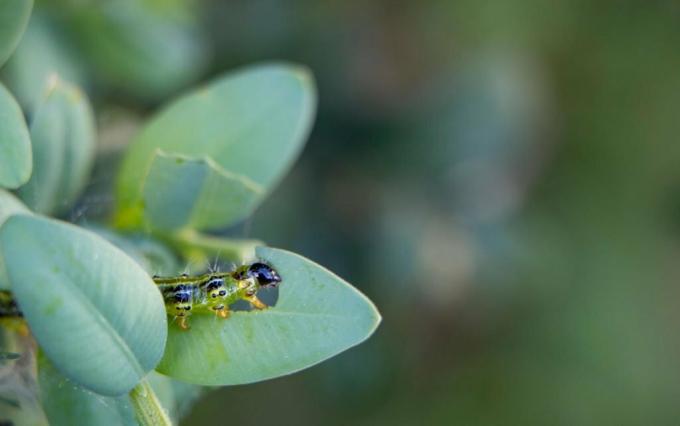The box tree moth feeds on the poisonous box tree. We explain whether caterpillars or butterflies are poisonous and whether they can be touched safely.

Many regions of Germany are from Box tree moth (Cydalima perspectalis) affected. When controlling and fighting it, we get uncomfortably close to it. The bright green color and fine hairs of the caterpillars therefore raise the question of whether the animals are perhaps poisonous. Fortunately, we can reassure you. Because as annoying as it is, the moth can do little to us.
Can you now touch them with your hands and can't birds perhaps kill the pests for us? The following paragraphs will fully explain the toxicity of the box tree moth.
contents
- Is the box tree moth poisonous?
- Is the boxwood moth poisonous to birds?
-
Can you touch the box tree moth with your hands?
- Pick up the box tree moth with your hands
Is the box tree moth poisonous?
We have to answer this question with yes first. Because the larvae of the boxwood moth feed on the foliage of the
Boxwood (Buxus), which contains around 70 different, mostly poisonous, alkaloids in leaves and bark. Young larvae even prefer older leaves, which contain alkaloids in particularly high concentrations. Some of these substances are used by the Caterpillars of the moth metabolized, others stored in the body as an effective protection against eating. In this way, the offspring of the box tree moth become inedible or even poisonous to many possible enemies. For us humans, too, the toxins contained in boxwood are actually poisonous. The good news is: touching Buxus and boxwood moth is still harmless according to current knowledge, because the alkaloids involved are not absorbed through the skin. But it is better not to eat the caterpillars. And the moths can also be touched without worry.Tip: Allergic skin inflammation after contact with the boxwood is possible, albeit very rare. Always keep an eye on children when handling boxwood and boxwood moth caterpillars.

Is the boxwood moth poisonous to birds?
Although the boxwood moth caterpillars are believed to be poisonous to birds, various sources report that Tits, redstart, sparrows, starlings and even wasps are gradually getting the taste of the fat larvae come. Whether they are actually suitable as natural opponents remains to be seen, however, because it was also observed several times that birds regurgitate their prey after a while and disdain. The adults Boxwood moth however, birds like to eat.
Tip: Anyone who wants to benefit from the birds' interest in the boxwood moth can encourage the winged beneficial insects in the garden. More about this and more biological methods of combating the borer can also be found in our special article.
Can you touch the box tree moth with your hands?
The moths of the boxwood moth can be touched safely. This also applies, with restrictions, to the caterpillars, because allergic skin reactions could only occur in extremely rare cases. What would do little harm to an adult could possibly be more unpleasant for children, which is why you should not let them play long and intensively with the caterpillars. However, brief touches are usually not a problem. If you are concerned and want to be on the safe side, you can wear gloves when collecting or examining the caterpillars and wash your hands after contact with them.
Pick up the box tree moth with your hands
The collection of caterpillars of the boxwood moth can be a first step in the control of the disease if the infestation is very low. Were only about a few Moth eggs placed outdoors, the hatched larvae can be removed with the hands before they venture into the dense interior of the shrub. If you find already well developed, five centimeter long caterpillars on the outside of the bush, you can assume that the infestation is already so severe that it is no longer effective. You should now use other means to control the box tree moth. Here you will find all the information you need to know about the Fighting the borer.

Tip: Even easier than collecting it is cutting the boxwood in order to remove both eggs and larvae. The clippings are packed in closed bags and disposed of in the residual waste. A cut no later than two weeks after observing the butterfly flight - discovered, for example, with one Pheromone trap - is the first step towards a moth-free boxwood. If you are looking for a pheromone trap, you can find the Plantura in our shop Buy moth trap.



